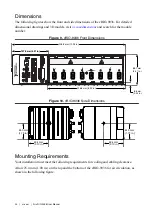
USB Configuration Submenu
The USB configuration submenu contains the USB host ports settings. The factory default
settings provide the most compatible and optimal configuration.
•
USB Devices—This item lists the total number of devices detected in the system,
categorized by device type.
•
Legacy USB Support—This setting specifies whether legacy USB support is enabled.
Legacy USB support refers to the ability to use a USB keyboard and mouse during
system boot or in a legacy operating system such as DOS.
•
Overcurrent Reporting—This setting allows the BIOS to notify the operating system
about any USB ports that source too much current. The default value is
Disabled
.
Hardware overcurrent protection is always active and cannot be disabled.
•
Transfer Timeout—This setting specifies the timeout value for Control, Bulk, and
Interrupt USB transfers. The default value is
20
seconds.
•
Device Reset Timeout—This setting specifies the number of seconds the POST waits for
a USB mass storage device to start. The default value is
20
seconds.
•
Device Power-Up Delay—This setting specifies the maximum time a device takes before
enumerating. Valid options are
Auto
and
Manual
. The default value is
Auto
. When set to
Auto
, a root port is granted 100 ms, and the delay value of a hub port is assigned from the
hub descriptor.
•
Device Power-Up Delay in Seconds—This setting specifies the number of seconds the
POST waits for a USB device or hub to power on. This setting is only visible when the
Device Power-Up Delay is set to
Manual
. The default value is
5
seconds.
•
Emulation Type—This setting specifies how the BIOS presents the USB mass storage
device to the system for each detected USB mass storage device. This option presents a
USB mass storage device as a floppy, Zip, hard disk, or CD-ROM drive. The default
value is
Auto
, which allows the BIOS to treat small USB flash disk drives as floppy
drives and larger USB flash disk drives as hard disk drives.
Boot Setup Menu
The Boot Setup menu contains setting related to the boot process and the boot device priority.
•
Boot Settings Configuration Submenu—This item accesses the Boot Settings
Configuration submenu.
•
PXE Network Boot—This setting specifies whether the PXE network boot agent is
enabled. The Intel Boot Agent is visible in the Boot Option Priorities menu when
enabled, allowing you to boot from a PXE server on the local subnet. The Intel Boot
Agent device names are preceded by IBA GE Slot 0200 v1553 in the Boot Option
Priorities menu. The system must be restarted for this setting to take effect. The default
value is
Disabled
.
•
Boot Option Priorities—These settings specify the order in which the BIOS checks for
bootable devices, including the local hard disk drive, removable devices such as USB
36
|
ni.com
|
NI cRIO-9036 User Manual





































